12/21/2017
12 Safety Tips for Any Industry

Warehouses, foundries, construction sites and factories can be some of the most dangerous places to work when it comes to accidents and injury: large and moving machinery such as forklifts, carrying heavy loads such as pallets and heavy equipment can be hazardous for you and your workers.With the holidays approaching, we decided it was time to create our own little holiday. Check out our 12 Tips for Safety and get inspired to help make your own work environments safer and more productive: Day 1. Know your safety protocols- Make sure emergency exits are clearly marked and you know the quickest route to safety from any location in the facility. In addition to knowing where your emergency exits are located, it is important to know where first-aid kits and supplies are kept. In an emergency, you dont want to be faced with the task of locating the first aid kit.Day 2.Perfect Posture - If you work at a desk, make sure that your shoulders
Day 1. Know your safety protocols- Make sure emergency exits are clearly marked and you know the quickest route to safety from any location in the facility. In addition to knowing where your emergency exits are located, it is important to know where first-aid kits and supplies are kept. In an emergency, you dont want to be faced with the task of locating the first aid kit.Day 2.Perfect Posture - If you work at a desk, make sure that your shoulders  are in line with your hips to avoid back problems. When picking things up, use correct form so your back doesnt get hurt, and whatever you do, avoid stooping and twisting. If you have access to ergonomically designed furniture and safety equipment so that everything you need is comfortably within reach.
are in line with your hips to avoid back problems. When picking things up, use correct form so your back doesnt get hurt, and whatever you do, avoid stooping and twisting. If you have access to ergonomically designed furniture and safety equipment so that everything you need is comfortably within reach.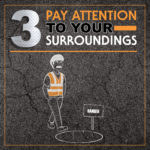 Day 3.Pay Attention to Your Surroundings - This tip requires that you first know what particular hazards your job or workplace can entail. Once youve learned about the risks, you will be able to steer clear of any potentially hazardous areas or situations. Day 4.Take regular breaks - There are many work-related injuries
Day 3.Pay Attention to Your Surroundings - This tip requires that you first know what particular hazards your job or workplace can entail. Once youve learned about the risks, you will be able to steer clear of any potentially hazardous areas or situations. Day 4.Take regular breaks - There are many work-related injuries  andillnesses that occur because of fatigue. Taking regular breaks helps you stay fresh and alert on the job. One useful tip for staying alert is to schedule the most difficult tasks when your concentration is at its best, like first thing in the morning, or later in the afternoon depending on your own workflow.
andillnesses that occur because of fatigue. Taking regular breaks helps you stay fresh and alert on the job. One useful tip for staying alert is to schedule the most difficult tasks when your concentration is at its best, like first thing in the morning, or later in the afternoon depending on your own workflow. Day 5. Report Unsafe Conditions to Your Supervisor - Its your job to make sure that your work environment stays safe for you and your fellow employees. Its your supervisor's job to provide you with the resources and materials to make that happen. They need to be informed about any workplace safety hazards or risks. Your supervisor is legally obligated to ensure that employees have a safe working environment. Help keep them informed and keep your work environment safe!Day 6. Keep Emergency Exits Easily Accessible - Quick, easy access to exits
Day 5. Report Unsafe Conditions to Your Supervisor - Its your job to make sure that your work environment stays safe for you and your fellow employees. Its your supervisor's job to provide you with the resources and materials to make that happen. They need to be informed about any workplace safety hazards or risks. Your supervisor is legally obligated to ensure that employees have a safe working environment. Help keep them informed and keep your work environment safe!Day 6. Keep Emergency Exits Easily Accessible - Quick, easy access to exits 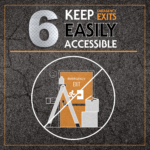 are necessary for any work environment. Keep the pathways to these exits clear and free of debris in order to ensure a quick and hasty escape, should you need one. Its also recommended to keep clear access to equipment shutoffs in case you need to quickly stop them from functioning.
are necessary for any work environment. Keep the pathways to these exits clear and free of debris in order to ensure a quick and hasty escape, should you need one. Its also recommended to keep clear access to equipment shutoffs in case you need to quickly stop them from functioning. Day 7. Dont Try to Impress - We cant stress this enough, use mechanical aids whenever possible. If you are faced with lifting and moving heavy objects all day long, dont try and show off in front of your coworkers by lifting heavy materials improperly, or by trying to lift something that you shouldnt be lifting in the first place. Use the dollies, forklifts and hand trucks that you have available to make your job easier and prevent injuries. Also remember to wear protective clothing including hard hats, gloves, vests, masks, belts, eyewear and proper safety footwear.Day 8. Reduce stress in the workplace - Stress can lead to depression and
Day 7. Dont Try to Impress - We cant stress this enough, use mechanical aids whenever possible. If you are faced with lifting and moving heavy objects all day long, dont try and show off in front of your coworkers by lifting heavy materials improperly, or by trying to lift something that you shouldnt be lifting in the first place. Use the dollies, forklifts and hand trucks that you have available to make your job easier and prevent injuries. Also remember to wear protective clothing including hard hats, gloves, vests, masks, belts, eyewear and proper safety footwear.Day 8. Reduce stress in the workplace - Stress can lead to depression and 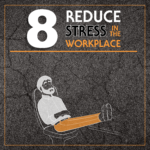 concentration problems. Common causes of workplace stress include long hours, heavy workload, job insecurity and conflicts with coworkers or managers. Take your concerns about workplace stress to your supervisor to see how they might help you address them.
concentration problems. Common causes of workplace stress include long hours, heavy workload, job insecurity and conflicts with coworkers or managers. Take your concerns about workplace stress to your supervisor to see how they might help you address them.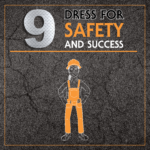 Day 9. Dress for Safety and Success- Avoid wearing baggy or excessively loose-fitting clothing. As with any job, it is important to dress the part. That means wearing comfortable clothing that is not too baggy. This will help protect you from getting caught anything that might be on the side of your path or line of walking. Proper safety toe footwear is also important in your line of work.Day 10. Use Tools and Machines Properly - Take the proper precautions when
Day 9. Dress for Safety and Success- Avoid wearing baggy or excessively loose-fitting clothing. As with any job, it is important to dress the part. That means wearing comfortable clothing that is not too baggy. This will help protect you from getting caught anything that might be on the side of your path or line of walking. Proper safety toe footwear is also important in your line of work.Day 10. Use Tools and Machines Properly - Take the proper precautions when  using tools, and never take shortcuts. Taking shortcuts is the leading cause of workplace injury. Its a huge safety risk to use scaffolding as a ladder or one tool in place of another for a specific job. Using tools the right way greatly reduces the chance of workplace injury.
using tools, and never take shortcuts. Taking shortcuts is the leading cause of workplace injury. Its a huge safety risk to use scaffolding as a ladder or one tool in place of another for a specific job. Using tools the right way greatly reduces the chance of workplace injury.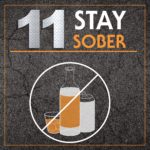 Day 11. Stay Sober- This one seems like a no-brainer, yet around three percent of workplace fatalities occur due to alcohol and drugs. When a workers ability to exercise judgment, coordination, motor control, concentration or alertness is compromised, this leads to any number of risks for workplace injury and fatalities.Day 12. Keep the Lines of Communication Open - Its important to be aware
Day 11. Stay Sober- This one seems like a no-brainer, yet around three percent of workplace fatalities occur due to alcohol and drugs. When a workers ability to exercise judgment, coordination, motor control, concentration or alertness is compromised, this leads to any number of risks for workplace injury and fatalities.Day 12. Keep the Lines of Communication Open - Its important to be aware of the government and company safety regulations that your company and industry need to abide by. However, it is just as important to create and foster clear lines of communication when it comes to the details surrounding the implementation of these rules and regulations within your company. This includes taking the time to properly train new hires, as well as communicate up to date information regarding safety protocols and plans of action.Hopefully, the 12 Tips for Safety gave you some ideas and inspiration on how to improve your own companys safety culture. For more tips, tricks, and other questions check us out at www.safgard.com
of the government and company safety regulations that your company and industry need to abide by. However, it is just as important to create and foster clear lines of communication when it comes to the details surrounding the implementation of these rules and regulations within your company. This includes taking the time to properly train new hires, as well as communicate up to date information regarding safety protocols and plans of action.Hopefully, the 12 Tips for Safety gave you some ideas and inspiration on how to improve your own companys safety culture. For more tips, tricks, and other questions check us out at www.safgard.com
 Day 1. Know your safety protocols- Make sure emergency exits are clearly marked and you know the quickest route to safety from any location in the facility. In addition to knowing where your emergency exits are located, it is important to know where first-aid kits and supplies are kept. In an emergency, you dont want to be faced with the task of locating the first aid kit.Day 2.Perfect Posture - If you work at a desk, make sure that your shoulders
Day 1. Know your safety protocols- Make sure emergency exits are clearly marked and you know the quickest route to safety from any location in the facility. In addition to knowing where your emergency exits are located, it is important to know where first-aid kits and supplies are kept. In an emergency, you dont want to be faced with the task of locating the first aid kit.Day 2.Perfect Posture - If you work at a desk, make sure that your shoulders  are in line with your hips to avoid back problems. When picking things up, use correct form so your back doesnt get hurt, and whatever you do, avoid stooping and twisting. If you have access to ergonomically designed furniture and safety equipment so that everything you need is comfortably within reach.
are in line with your hips to avoid back problems. When picking things up, use correct form so your back doesnt get hurt, and whatever you do, avoid stooping and twisting. If you have access to ergonomically designed furniture and safety equipment so that everything you need is comfortably within reach. Day 3.Pay Attention to Your Surroundings - This tip requires that you first know what particular hazards your job or workplace can entail. Once youve learned about the risks, you will be able to steer clear of any potentially hazardous areas or situations. Day 4.Take regular breaks - There are many work-related injuries
Day 3.Pay Attention to Your Surroundings - This tip requires that you first know what particular hazards your job or workplace can entail. Once youve learned about the risks, you will be able to steer clear of any potentially hazardous areas or situations. Day 4.Take regular breaks - There are many work-related injuries  andillnesses that occur because of fatigue. Taking regular breaks helps you stay fresh and alert on the job. One useful tip for staying alert is to schedule the most difficult tasks when your concentration is at its best, like first thing in the morning, or later in the afternoon depending on your own workflow.
andillnesses that occur because of fatigue. Taking regular breaks helps you stay fresh and alert on the job. One useful tip for staying alert is to schedule the most difficult tasks when your concentration is at its best, like first thing in the morning, or later in the afternoon depending on your own workflow. Day 5. Report Unsafe Conditions to Your Supervisor - Its your job to make sure that your work environment stays safe for you and your fellow employees. Its your supervisor's job to provide you with the resources and materials to make that happen. They need to be informed about any workplace safety hazards or risks. Your supervisor is legally obligated to ensure that employees have a safe working environment. Help keep them informed and keep your work environment safe!Day 6. Keep Emergency Exits Easily Accessible - Quick, easy access to exits
Day 5. Report Unsafe Conditions to Your Supervisor - Its your job to make sure that your work environment stays safe for you and your fellow employees. Its your supervisor's job to provide you with the resources and materials to make that happen. They need to be informed about any workplace safety hazards or risks. Your supervisor is legally obligated to ensure that employees have a safe working environment. Help keep them informed and keep your work environment safe!Day 6. Keep Emergency Exits Easily Accessible - Quick, easy access to exits  are necessary for any work environment. Keep the pathways to these exits clear and free of debris in order to ensure a quick and hasty escape, should you need one. Its also recommended to keep clear access to equipment shutoffs in case you need to quickly stop them from functioning.
are necessary for any work environment. Keep the pathways to these exits clear and free of debris in order to ensure a quick and hasty escape, should you need one. Its also recommended to keep clear access to equipment shutoffs in case you need to quickly stop them from functioning. Day 7. Dont Try to Impress - We cant stress this enough, use mechanical aids whenever possible. If you are faced with lifting and moving heavy objects all day long, dont try and show off in front of your coworkers by lifting heavy materials improperly, or by trying to lift something that you shouldnt be lifting in the first place. Use the dollies, forklifts and hand trucks that you have available to make your job easier and prevent injuries. Also remember to wear protective clothing including hard hats, gloves, vests, masks, belts, eyewear and proper safety footwear.Day 8. Reduce stress in the workplace - Stress can lead to depression and
Day 7. Dont Try to Impress - We cant stress this enough, use mechanical aids whenever possible. If you are faced with lifting and moving heavy objects all day long, dont try and show off in front of your coworkers by lifting heavy materials improperly, or by trying to lift something that you shouldnt be lifting in the first place. Use the dollies, forklifts and hand trucks that you have available to make your job easier and prevent injuries. Also remember to wear protective clothing including hard hats, gloves, vests, masks, belts, eyewear and proper safety footwear.Day 8. Reduce stress in the workplace - Stress can lead to depression and  concentration problems. Common causes of workplace stress include long hours, heavy workload, job insecurity and conflicts with coworkers or managers. Take your concerns about workplace stress to your supervisor to see how they might help you address them.
concentration problems. Common causes of workplace stress include long hours, heavy workload, job insecurity and conflicts with coworkers or managers. Take your concerns about workplace stress to your supervisor to see how they might help you address them. Day 9. Dress for Safety and Success- Avoid wearing baggy or excessively loose-fitting clothing. As with any job, it is important to dress the part. That means wearing comfortable clothing that is not too baggy. This will help protect you from getting caught anything that might be on the side of your path or line of walking. Proper safety toe footwear is also important in your line of work.Day 10. Use Tools and Machines Properly - Take the proper precautions when
Day 9. Dress for Safety and Success- Avoid wearing baggy or excessively loose-fitting clothing. As with any job, it is important to dress the part. That means wearing comfortable clothing that is not too baggy. This will help protect you from getting caught anything that might be on the side of your path or line of walking. Proper safety toe footwear is also important in your line of work.Day 10. Use Tools and Machines Properly - Take the proper precautions when  using tools, and never take shortcuts. Taking shortcuts is the leading cause of workplace injury. Its a huge safety risk to use scaffolding as a ladder or one tool in place of another for a specific job. Using tools the right way greatly reduces the chance of workplace injury.
using tools, and never take shortcuts. Taking shortcuts is the leading cause of workplace injury. Its a huge safety risk to use scaffolding as a ladder or one tool in place of another for a specific job. Using tools the right way greatly reduces the chance of workplace injury. Day 11. Stay Sober- This one seems like a no-brainer, yet around three percent of workplace fatalities occur due to alcohol and drugs. When a workers ability to exercise judgment, coordination, motor control, concentration or alertness is compromised, this leads to any number of risks for workplace injury and fatalities.Day 12. Keep the Lines of Communication Open - Its important to be aware
Day 11. Stay Sober- This one seems like a no-brainer, yet around three percent of workplace fatalities occur due to alcohol and drugs. When a workers ability to exercise judgment, coordination, motor control, concentration or alertness is compromised, this leads to any number of risks for workplace injury and fatalities.Day 12. Keep the Lines of Communication Open - Its important to be aware of the government and company safety regulations that your company and industry need to abide by. However, it is just as important to create and foster clear lines of communication when it comes to the details surrounding the implementation of these rules and regulations within your company. This includes taking the time to properly train new hires, as well as communicate up to date information regarding safety protocols and plans of action.Hopefully, the 12 Tips for Safety gave you some ideas and inspiration on how to improve your own companys safety culture. For more tips, tricks, and other questions check us out at www.safgard.com
of the government and company safety regulations that your company and industry need to abide by. However, it is just as important to create and foster clear lines of communication when it comes to the details surrounding the implementation of these rules and regulations within your company. This includes taking the time to properly train new hires, as well as communicate up to date information regarding safety protocols and plans of action.Hopefully, the 12 Tips for Safety gave you some ideas and inspiration on how to improve your own companys safety culture. For more tips, tricks, and other questions check us out at www.safgard.com Categories: Safety Tips | Authored by: Saf-Gard | Posted: 12/21/2017